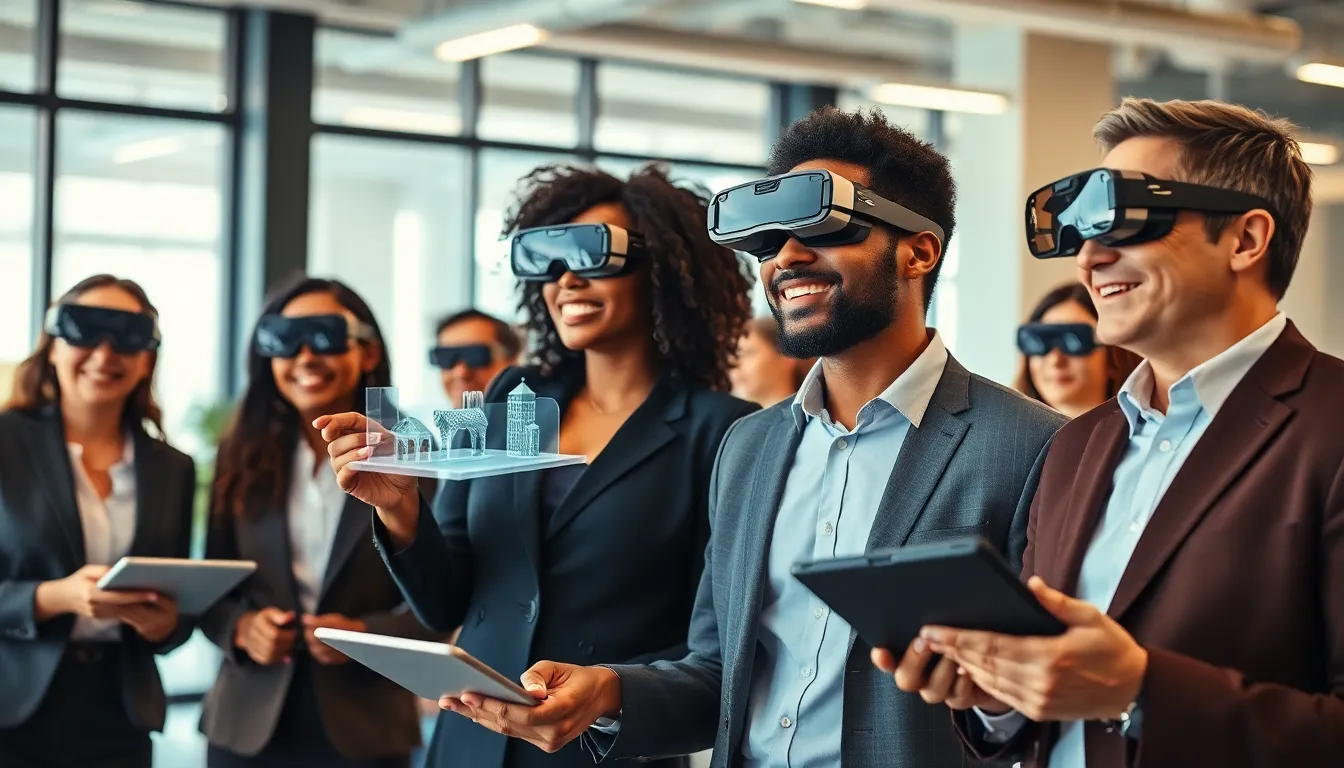Imagine walking into a store where the shoes you try on come with a virtual catwalk, or a restaurant menu that lets you see your meal in 3D before you order. Welcome to the world of augmented reality (AR) in business, where the line between the digital and physical blurs in the most exciting ways. Companies are no longer just selling products; they’re crafting experiences that engage customers like never before.
As AR technology evolves, it’s transforming industries from retail to real estate, and businesses that embrace this innovation are reaping the rewards. With a sprinkle of creativity and a dash of tech-savvy, augmented reality isn’t just a futuristic concept—it’s a game-changer. Buckle up as we explore how businesses can harness the power of AR to captivate audiences and boost their bottom line.
Table of Contents
ToggleOverview of Augmented Reality Business
Augmented reality (AR) transforms how businesses interact with customers by blending digital elements with the real world. Companies in various sectors, such as retail, real estate, and healthcare, use AR to improve engagement and drive sales. Retailers, for example, implement AR applications that allow customers to visualize products in their own environments before making a purchase.
Real estate professionals leverage AR to give potential buyers immersive property tours, enhancing the decision-making process. Healthcare providers utilize AR for training, enabling medical students to interact with 3D models of human anatomy, which supports better understanding and retention of information.
Statistics indicate that the global augmented reality market size could exceed $300 billion by 2024, reflecting its growing importance across industries. Businesses that adopt AR technology often see an increase in customer satisfaction and loyalty. Case studies reveal that brands utilizing AR experience higher conversion rates, as interactive and engaging experiences foster deeper connections with consumers.
Competitive advantages emerge when companies invest in AR solutions. By showcasing products innovatively, businesses can stand out in crowded markets. Analysis of user data shows that AR experiences lead to increased time spent with products, thereby enhancing the likelihood of purchase.
As AR technology continues to advance, further integration into business models becomes essential. Collaboration between designers, developers, and marketers drives successful AR implementations. Overall, augmented reality serves as a powerful tool that shapes future interactions between businesses and their customers.
Key Technologies in Augmented Reality

Augmented reality (AR) relies on various technologies that enhance its functionality in business applications. Key components include hardware and software innovations.
Hardware Components
AR systems utilize several hardware components that enable the overlay of digital content onto the physical environment. Cameras capture real-world images, while sensors track movement and position. Displays range from smartphones to AR glasses, providing immersive experiences. Processors manage data and execute software applications quickly. Companies frequently implement these hardware components to achieve high-quality visualizations and interactive experiences, leading to increased user engagement. Notably, devices like Microsoft HoloLens and Magic Leap One exemplify advanced AR hardware capabilities, pushing the boundaries of what’s possible in business settings.
Software Innovations
Software plays a critical role in the development and application of AR technologies. AR platforms, including Vuforia and ARKit, provide developers with tools to create engaging experiences seamlessly. Advanced computer vision algorithms enable accurate object recognition and environment mapping. Real-time rendering enhances the visual fidelity of digital elements, ensuring that users perceive them as part of their actual surroundings. Businesses leverage these software innovations to design tailored applications that meet customer needs. As these tools evolve, they offer greater functionality and ease of use, ultimately driving adoption across various sectors.
Applications of Augmented Reality in Business
Augmented reality (AR) transforms various sectors by enhancing interactions with customers through immersive technology. Companies increasingly explore its applications to improve user experiences.
Retail and E-Commerce
Retailers utilize AR to enrich customer engagement. By allowing customers to visualize products in their own spaces, retailers increase the likelihood of purchases. Brands such as IKEA provide AR apps that enable users to see furniture in their homes before buying. This personalized shopping experience enriches decision-making. Statistics reveal that AR-enhanced shopping can boost conversion rates by up to 40%.
Healthcare
In healthcare, AR plays a crucial role in training and patient care. Medical students benefit from interactive 3D models that illustrate human anatomy, promoting deeper understanding. Surgeons also leverage AR during operations to overlay vital information onto the surgical field. Research indicates that AR training programs improve retention rates, leading to enhanced skills in clinical practice. With its applications, AR not only enhances educational experiences but also accelerates the learning process for healthcare professionals.
Education and Training
AR revolutionizes education and training environments by providing immersive learning experiences. Students interact with digital content that complements traditional methods, fostering engagement. For instance, history classes utilizing AR can bring historical sites to life, making learning more captivating. Additionally, companies apply AR for employee training, simulating real-life scenarios for skill development. Data shows that AR-based training can reduce learning time by 60%, creating a more efficient pathway to proficiency.
Benefits of Implementing Augmented Reality in Business
Augmented reality (AR) offers significant advantages for businesses seeking to enhance their operations and customer interactions. These benefits manifest clearly in areas such as customer engagement and operational efficiency.
Enhanced Customer Engagement
Enhanced customer engagement results from AR’s immersive experiences. Brands can create interactive environments that capture consumer attention effectively. For instance, customers visualizing products in their spaces fosters decision-making confidence. Industry leaders like IKEA report conversion rate increases of up to 40%, demonstrating substantial financial benefits. Retailers that implement AR experiences often see prolonged engagement durations. Customers appreciate the ability to try before they buy, enriching their overall experience. Statistics show that up to 70% of consumers express a preference for AR-enhanced shopping, indicating a growing trend toward interactive retail.
Improved Operational Efficiency
Improved operational efficiency emerges from AR’s transformative capabilities. Staff training becomes more effective through interactive simulations, reducing training time significantly. Medical professionals utilize AR to visualize complex procedures, enhancing skill retention rates. Companies leveraging AR technology streamline processes, resulting in faster service delivery. Businesses report decreased error rates as employees engage with real-time data overlays. With AR, asset management becomes visually intuitive, facilitating enhanced inventory control and tracking. Research indicates that AR technology can improve productivity by around 30%, underscoring its contribution to operational excellence.
Challenges Faced by Augmented Reality Businesses
Augmented reality businesses encounter various challenges that can impact their growth and effectiveness. These hurdles include technical limitations and issues with market adoption.
Technical Limitations
Technical limitations hinder the full potential of augmented reality. Device constraints often restrict the quality of user experiences. Many smartphones lack the advanced hardware required for seamless AR applications, leading to performance issues. Additionally, software integration poses challenges. Inconsistent compatibility with various platforms can inhibit developers from reaching broader audiences. Rendering and latency issues further complicate application performance. As AR technology evolves, keeping up with advancements remains crucial for businesses aiming to provide optimal experiences.
Market Adoption Issues
Market adoption issues affect widespread utilization of augmented reality. Many potential users remain unaware of AR’s benefits, leading to hesitancy in adoption. Skepticism regarding the technology’s practicality also plays a role. Businesses often find it challenging to justify the investment required for AR implementation. Economic factors can impact decision-making as companies weigh costs against expected returns. Moreover, insufficient understanding of target audiences prevents AR businesses from creating tailored experiences. Solving these issues can encourage greater acceptance and integration of augmented reality into everyday practices.
Future Trends in Augmented Reality Business
Emerging trends are shaping the future of augmented reality in business. One significant trend involves the rise of AR in remote assistance. Industries increasingly leverage AR to provide real-time guidance to technicians and customers, enhancing service efficiency and reducing downtime.
Innovations in AR-enabled e-commerce directly boost customer engagement. Retailers are integrating AR into online shopping experiences, allowing consumers to visualize products in real-world settings. Examples include brands that report notable increases in conversion rates, showcasing the effectiveness of these strategies.
Healthcare continues to embrace AR for both training and operational purposes. Surgeons benefit from AR overlays during procedures, providing critical information that enhances precision. Medical education utilizes AR to create interactive learning environments, improving student comprehension and retention.
Training and collaboration also evolve with AR technology, offering immersive experiences. Employees engage in realistic simulations that foster skill development, significantly reducing onboarding time. Firms experience productivity gains as they adopt these methods, leading to streamlined operations.
Adoption of AR in marketing campaigns proves advantageous. Marketing teams now incorporate AR to create captivating advertisements that resonate with audiences. Statistics reveal that AR-infused content leads to higher interaction rates, encouraging brands to invest more resources in creative AR applications.
Challenges persist as businesses navigate AR implementation. Technical limitations, such as device capabilities and software compatibility, often act as barriers. Addressing market skepticism remains crucial for wider adoption, with education proving essential for potential users.
Collaboration among stakeholders is necessary for successful AR deployment. Designers, developers, and marketers must unite to create cohesive strategies that maximize AR’s potential in various sectors. Organizations that embrace these future trends position themselves to thrive in an increasingly digital landscape.
Augmented reality stands at the forefront of business innovation. Its ability to create immersive experiences is reshaping how companies engage with customers. As AR technology continues to evolve, organizations that embrace it can unlock significant advantages in customer satisfaction and operational efficiency.
The potential of AR in enhancing training and collaboration further underscores its value across various sectors. While challenges remain, the future is bright for businesses willing to invest in AR solutions. By fostering collaboration among key stakeholders, companies can harness the full power of augmented reality to navigate an increasingly digital landscape and drive growth.








